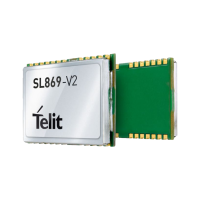making an RF short at one end of the stub to appear as an RF open at the other
end. The RF short is created by the good quality RF capacitor operating at self-
resonance.
The choice between the two would be determined by:
• RF path loss introduced by either the inductor or quarter wave stub.
• Cost of the inductor.
• Space availability for the quarter wave stub.
Simulations done by Telit show the following results:
Table 30: Inductor Loss
Since this additional loss occurs after the LNA, it is generally not significant unless the
circuit is being designed to work with both active and passive antennas.
RF Interference
RF Interference into the GNSS receiver tends to be the biggest problem when
determining why the system performance is not meeting expectations. As mentioned
earlier, the GNSS signals are at -130 dBm and lower. If signals higher than this are
presented to the receiver, the RF front end can be overdriven. The receiver can reject up
to 12 in-band CW jamming signals, but would still be affected by non-CW signals.
The most common source of interference is digital noise, often created by the fast rise
and fall times and high clock speeds of modern digital circuitry. For example, a popular
netbook computer uses an Atom processor clocked at 1.6 GHz. This is only 25 MHz away
from the GNSS signal, and depending upon temperature of the SAW filter, can be within
its passband. Because of the nature of the address and data lines, this would be
broadband digital noise at a relatively high level.
Such devices are required to adhere to a regulatory standard for emissions such as FCC
Part 15 Subpart J Class B or CISPR 22. However, these regulatory emission levels are far
higher than the GNSS signal strength.

